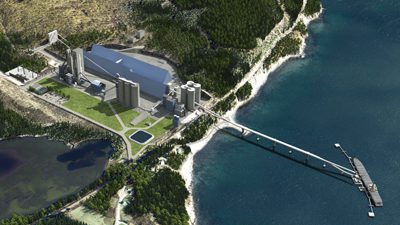St Marys Cement, McInnis Plant, Québec

Location: Port-Daniel—Gascons, Québec
Owner/Operator: St Marys Cement, Voratorim Cimentos North America
In 2017, after three years of construction, McInnis Cement was completed, and operations began at what is now the largest cement plant in the province of Quebec. More than $1 billion was invested in the facility and related network of terminals. The industrial complex produces three types of cement, and the mineralogy of the on-site limestone quarry contains the perfect balance of ingredients to produce high-performing Portland cement. With the company’s Portland cement plant alongside its limestone quarry and deep-water marine terminal on the southern coast of the Gaspé Peninsula with easy access to the St Lawrence River and the Atlantic Ocean, the plant is able to competitively service critical markets in Canada and the U.S. Eastern seaboard. The facility has been part of the Votorantim Cimentos North America family since 2021, and is today operating as St Marys Cement, McInnis Plant.
Facility Acoustic Assessment
HGC was retained by the facility to update the noise impact study of their operations. All previous noise impact studies had been undertaken prior to the commissioning of the plant. As a result, these studies were entirely predictive and relied on estimated sound levels from the equipment and conservative assumptions regarding the operations at the facility.
The updated study was based on noise measurements of the actual equipment currently operating at the facility. HGC staff measured noise emissions from each source at the facility using advanced sound intensity instrumentation and techniques. The goal of these measurements was to quantify the sound emissions from the plant operations alone, without any interference from background sound (e.g. road traffic noise, natural sounds).
Computational Acoustic Model of the McInnis Operation
The results of the measurements were then used to build a computerized acoustical model of the facility and the surrounding environment, where contribution from each individual source (and that of the overall operation) were quantified. The results of these measurements showed that the noise impact initially estimated by other consultants predictively was overestimated. The updated study conducted by HGC was useful to accurately determine the needs for any potential noise control – which was minimal relative to the extent initially expected based on the earlier study outcomes.
Facility Description
 The McInnis operation consists of two principal operations: the cement plant and an adjacent quarry that provides limestone to the cement plant.
The McInnis operation consists of two principal operations: the cement plant and an adjacent quarry that provides limestone to the cement plant.
The open quarry employs various mobile equipment to extract and transport raw materials to the processing equipment of the cement plant. The cement plant incorporates a complex set of operations to produce different types of Portland cement, including crushing facilities, a raw mill, kiln system, finish mills, and a number of storage silos. The raw materials are fed into the plant via a set of conveyor belts directly from the primary and secondary crushers located at the west end of the quarry.
Primary Plant Noise Sources
The primary sources of noise at the facility are the kiln cooling system, a myriad of dust collectors, the primary and secondary crushers, cooling equipment, and process fans with exhaust stacks.
Acoustical consulting services delivered:
- A detailed acoustical assessment and Noise Impact Study in accordance with the guidelines of the Quebec Ministère de l’Environnement et de la Lutte contre les changements climatiques (“MELCC”) instruction note 98-01
- Comprehensive Onsite and Offsite Acoustical Measurements
- Predictive Acoustical Modeling
- Noise Control Recommendations
